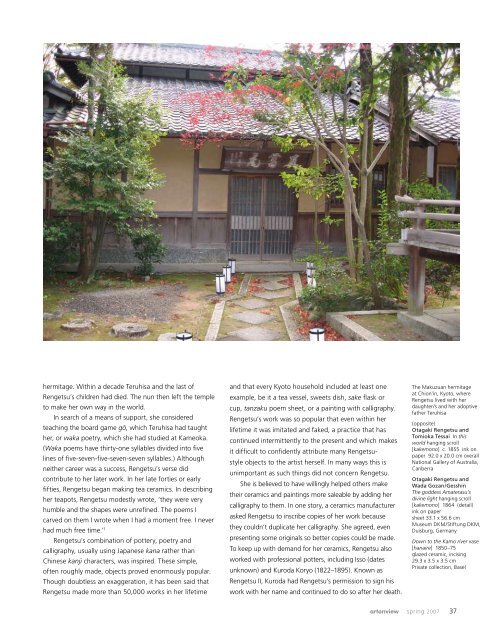Art Ew - National Gallery of Australia
Art Ew - National Gallery of Australia
Art Ew - National Gallery of Australia
Create successful ePaper yourself
Turn your PDF publications into a flip-book with our unique Google optimized e-Paper software.
hermitage. Within a decade Teruhisa and the last <strong>of</strong><br />
Rengetsu’s children had died. The nun then left the temple<br />
to make her own way in the world.<br />
In search <strong>of</strong> a means <strong>of</strong> support, she considered<br />
teaching the board game gõ, which Teruhisa had taught<br />
her, or waka poetry, which she had studied at Kameoka.<br />
(Waka poems have thirty-one syllables divided into five<br />
lines <strong>of</strong> five-seven-five-seven-seven syllables.) Although<br />
neither career was a success, Rengetsu’s verse did<br />
contribute to her later work. In her late forties or early<br />
fifties, Rengetsu began making tea ceramics. In describing<br />
her teapots, Rengetsu modestly wrote, ‘they were very<br />
humble and the shapes were unrefined. The poems I<br />
carved on them I wrote when I had a moment free. I never<br />
had much free time.’ 1<br />
Rengetsu’s combination <strong>of</strong> pottery, poetry and<br />
calligraphy, usually using Japanese kana rather than<br />
Chinese kanji characters, was inspired. These simple,<br />
<strong>of</strong>ten roughly made, objects proved enormously popular.<br />
Though doubtless an exaggeration, it has been said that<br />
Rengetsu made more than 50,000 works in her lifetime<br />
and that every Kyoto household included at least one<br />
example, be it a tea vessel, sweets dish, sake flask or<br />
cup, tanzaku poem sheet, or a painting with calligraphy.<br />
Rengetsu’s work was so popular that even within her<br />
lifetime it was imitated and faked, a practice that has<br />
continued intermittently to the present and which makes<br />
it difficult to confidently attribute many Rengetsustyle<br />
objects to the artist herself. In many ways this is<br />
unimportant as such things did not concern Rengetsu.<br />
She is believed to have willingly helped others make<br />
their ceramics and paintings more saleable by adding her<br />
calligraphy to them. In one story, a ceramics manufacturer<br />
asked Rengetsu to inscribe copies <strong>of</strong> her work because<br />
they couldn’t duplicate her calligraphy. She agreed, even<br />
presenting some originals so better copies could be made.<br />
To keep up with demand for her ceramics, Rengetsu also<br />
worked with pr<strong>of</strong>essional potters, including Isso (dates<br />
unknown) and Kuroda Koryo (1822–1895). Known as<br />
Rengetsu II, Kuroda had Rengetsu’s permission to sign his<br />
work with her name and continued to do so after her death.<br />
The Makuzuan hermitage<br />
at Chion’in, Kyoto, where<br />
Rengetsu lived with her<br />
daughter/s and her adoptive<br />
father Teruhisa<br />
(opposite)<br />
Otagaki Rengetsu and<br />
Tomioka Tessai In this<br />
world hanging scroll<br />
[kakemono] c. 1855 ink on<br />
paper 92.0 x 20.0 cm overall<br />
<strong>National</strong> <strong>Gallery</strong> <strong>of</strong> <strong>Australia</strong>,<br />
Canberra<br />
Otagaki Rengetsu and<br />
Wada Gozan/Gesshin<br />
The goddess Amaterasu’s<br />
divine light hanging scroll<br />
[kakemono] 1864 (detail)<br />
ink on paper<br />
sheet 33.1 x 56.6 cm<br />
Museum DKM/Stiftung DKM,<br />
Duisburg, Germany<br />
Down to the Kamo river vase<br />
[hanaire] 1850–75<br />
glazed ceramic, incising<br />
29.3 x 3.5 x 3.5 cm<br />
Private collection, Basel<br />
artonview spring 2007 37

















